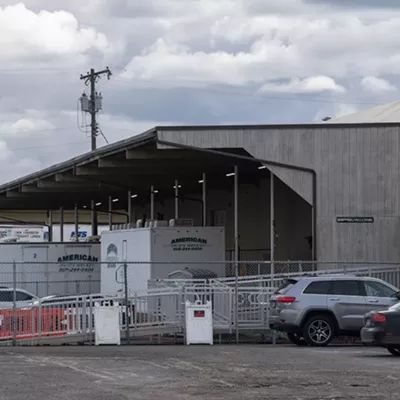We'd been told she'd be waiting outside. Sure enough, there she was, leaning forward on her cane, shaded by a sagging front porch, waiting for us to deliver her midday Meals on Wheels lunch. We'd spend two minutes talking to her about the weather and other minutiae, and it would probably be the highlight of Anna Atanasoff's day. Layers of silver duct tape have accumulated on top of her cane, allowing her arthritic fingers to grasp it. The silver of false teeth glints in her mouth. A black woolen head-scarf gives her a vaguely Eastern European look. Though wrinkled and careworn, her eyes are bright. She may need help disentangling the scarf from a bob of gray hair, but the smile never leaves her face. She's glad to have visitors.
On this particular day, she can look forward to a hot meal of baked ham with pineapple, scalloped potatoes, wheat bread, peaches and an oatmeal raisin bar. Meals on Wheels manages to distribute about 330 lunches on a typical day, working with just two-and-a-half fulltime positions. They've been doing so locally since 1967. The operation requires at least 40 volunteers each weekday, more than 70 in a given week. (Clients -- approximately 400 in all -- qualify by being homebound and 60 or older.)
These statistics came alive during a recent ride-along with MOW volunteer driver Bob Boyd. Animated and voluble, he's full of stories about the people he's met and the situations he's been thrown into during his five years of delivering meals. Now retired, Boyd was an insurance adjuster for years before handling claims and working as a risk manager for Avista. His motivation? "I enjoy it because I just like the people. You know there's a real need there. It's a relational thing: anything you say or do for them, they appreciate it."
Boyd certainly has the requisite generosity for the job. He talks about mistakes he made as a novice Meal-Wheeler: "When I first did this, I thought everybody got both a milk and a juice, so naturally, when I got about halfway through my route, I ran out. But we rectified that -- we stopped at a Safeway and replenished our juice allotment."
Keeping elderly shut-ins fed is the program's literal mission, but it's clear that the visits' social dimension matters just as much. Boyd estimates that for "about 95 percent" of the elderly people he serves, his visit is their only significant social contact during the day: "Most of them live in individual situations, and they don't know that many people in their neighborhood to begin with, sometimes, and then the older they get, the less they get out to see anybody else. So, yeah, most of these people, usually they're happy as a lark to see you. They don't see the mailman, they don't see the paper boy, so this is it.
"It's really all designed to keep the people from moving to a facility," he continues. "Losing their independence, that just crushes 'em. They have it in their minds that when they go to an institution, that's it, it's over."
For Anna, who manages a small wave as we drive off; for Mabel, with her roly-poly companion mutt; for Lenora, in housecoat and booties; and for Elmo, who has lived with his wife in their home for the past 56 years, Bob Boyd's wheels deliver a lot more than just meals.
Contact Volunteer Coordinator Peggy Doering
at Meals on Wheels at 456-6597.















